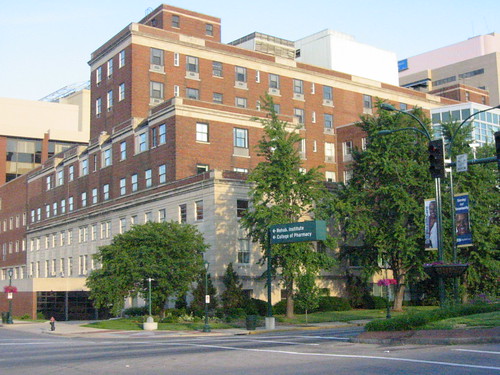
This afternoon the St. Louis Preservation Board will likely approve demolition of Jewish Hospital at Kingshighway & Forest Park Boulevards and the former Jewish Hospital School of Nursing across Parkview Place, which was previously denied demolition because plans for a replacement building were not in place. Today though schematic plans are in place to replace the buildings with new bed towers for both Barnes-Jewish and Children's Hospitals atop a joined podium that is proposed to span over Parkview Place. Next STL's post from last week has the full agenda for the Preservation Board meeting.
This post is not written to oppose the demolitions, but to reflect on certain aspects of the impending transformation. While the existing building might be able to renovated and retrofitted for uses such as medical office, research or bio-tech space as is being done with the Heritage Building in CORTEX, the old Jewish Hospital and School of Nursing would be very difficult if not impossible to convert into modern functional hospital facilities. Hospitals are required to meet much higher seismic standards than most other uses.
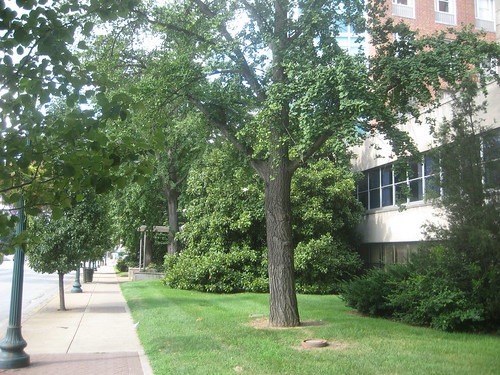
Besides the architecture, one of the most noticeable aspects of the existing buildings are the mature trees and other significant landscaping in the lawns along Kingshighway.

Turning the corner onto Parkview Place, there is a similar mature canopy between the street and the building complex.

The tallest portion of the old Jewish Hospital is only seven and a half stories and set back from all surrounding streets on a tiered base.
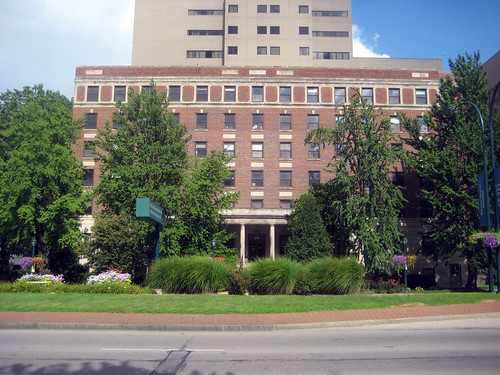
While the six and a half story Jewish Hospital Nursing School building does not have a tiered composition along Kingshighway, the setback from the sidewalk and mature trees gives a similar scale along the block face.
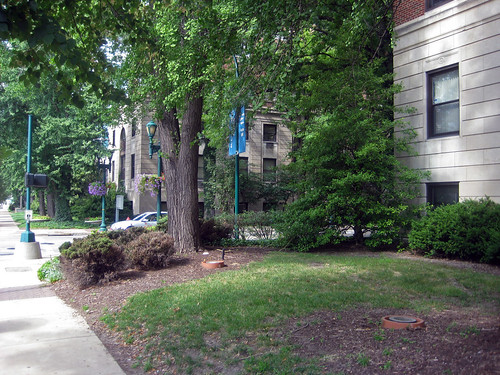
Standing in front of the School of Nursing building looking north, the setback, limestone base, red brick upper stories, similar design and detailing as well as landscaping provide a unifying appearance and scale along Kingshighway.
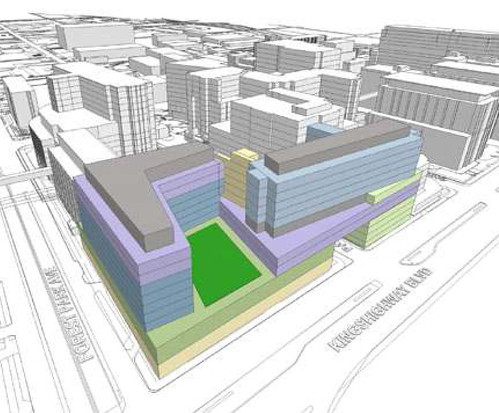
The massing model for the replacement structures show a base of two to four stories with the bed towers rising to about 12 stories, slightly shorter than the Siteman Center at the other end of the block at Euclid. In contrast to newer buildings south of Children's Hospital and the existing buildings to be removed, the base of new structures would not have a setback from the sidewalk. This is similar though to the condition that exists at Queeny Tower, where the parking garage base has no setback. The bed towers on the Kingshighway side would have an angled setback, but would continue up in line with the base along Forest Park Boulevard.

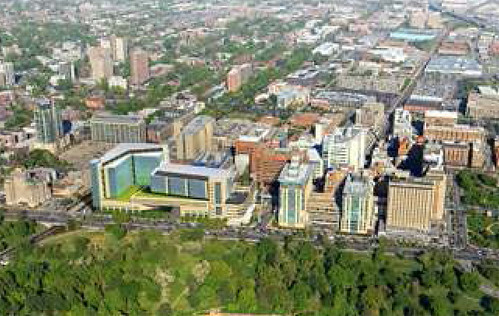
Aerial photos show the existing and proposed buildings at the north end of the hospital campus along Kingshighway. The view above appears to show an angled cutaway in the base (not seen in the massing model) as the building above bridges over Parkview Place.
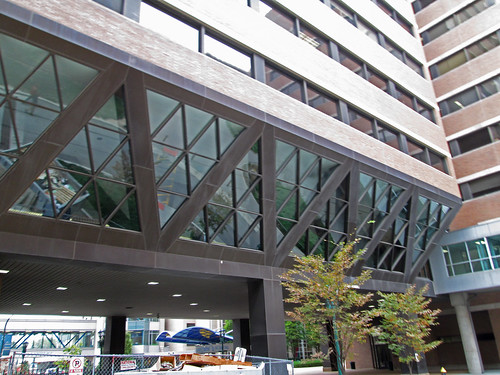
There is precedent for bridging a building over a street on the medical campus. The Clinical Sciences Research Building at the Washington University School of Medicine bridges over Children's Place, although this portion of the street has been converted to pedestrian use only. The large angled trusses on each side of the building successfully narrow the amount of space covered at the street and also provide very interesting spaces at the interior of the building.
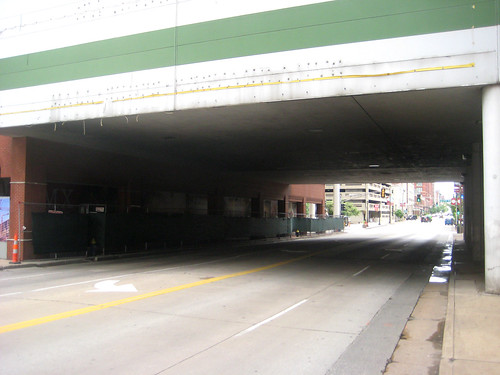
Anyone designing a building over a street though should be cautioned to avoid creating dark and desolate spaces that occur when the width of the bridge is too wide and the height to the underside is too low.
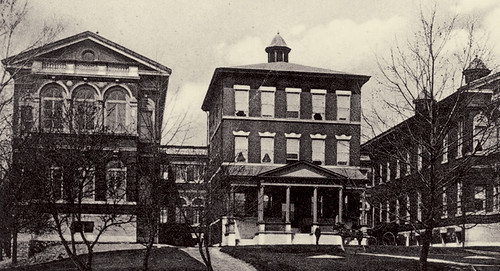
The Jewish Hospital of St.louis began with its first building located at 5415 Delmar Boulevard which opened in 1902 only able to house 30 beds. It was expanded in 1905 with symmetrical wings that brought the bed count to 100. By 1913 this expansion proved too small and land at Kingshighway & Forest Park Boulevards was purchased in 1915 as a site for a new facility. The building on Delmar was purchased by the neighboring Masonic Home who significantly remodeled it and built a twin building to the east. The site is now the location of the St. Louis Regional Psychiatric Stabilization Center, which was built in the mid-1990's.
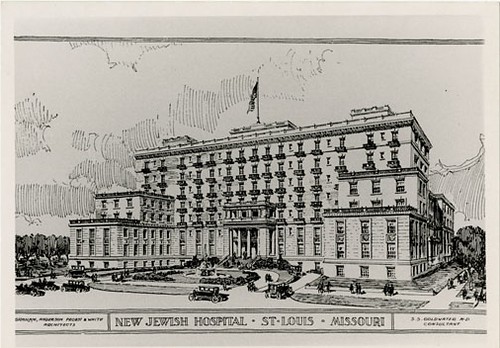
Above is the architectural rendering by Graham, Anderson, Probst & White of Chicago for the new Jewish Hospital on Kingshighway which was dedicated on May 16, 1926. The School of Nursing was opened three years later and connected to the hospital by a tunnel under Parkview Place.
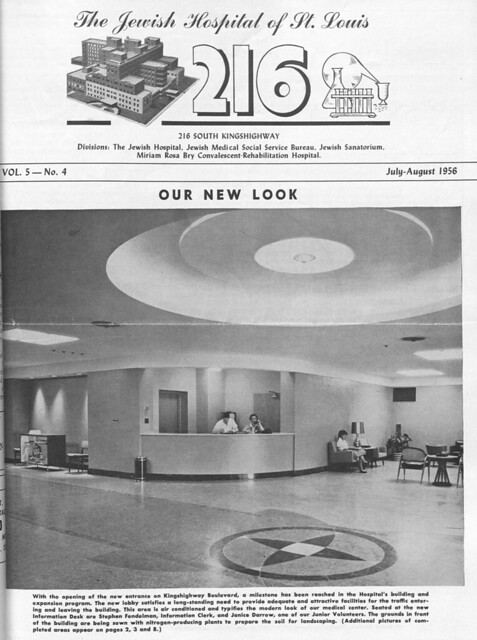
In 1956 the center wing was added to the hospital and the courtyard facing Kingshighway was infilled with a two story addition. Above is a photo of the new modern lobby created with the expansion.

The idea of going vertical at the Jewish Hospital site along Kingshighway is not new. This study drawing from the late 1960's shows a highrise addition along Forest Park Boulevard and second future tower in front of the original hospital along Kingshighway.
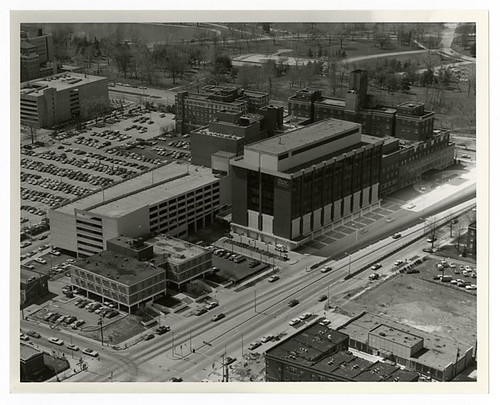
The Schoenberg Pavilion by Schwarz & Henmi Architects was opened in 1974 at eight stories in height, but a newspaper article about the building stated that the building was designed to be expanded vertically up to twenty stories. The Schoenberg building is the only portion of the Jewish Hospital complex that will not be demolished with the new expansion plans.
While Barnes & Jewish Hospitals formed an affiliation agreement in 1992 that led to the creation of BJC and officially merged in 1996, the old hospital building at Kingshighway & Forest Park for many retained the identity of Jewish Hospital. For many Barnes Hospital with the large East & West Pavilions facing Highway 40 still retains its identity. A recent article in the Jewish Light reflects on this passing of the independent identity of Jewish Hospital.

3 comments:
A sincere thank you for considering the trees which will also be erased when the site is cleared.
Is certainly seems from the rendering like a Wash Ave. style skybridge is planned that would be considerably wider and darker if lights aren't added. Hopefully people that need to walk that way can just cut through the public corridors inside the buildings.
The bridge over Parkview appears to be quite tall - perhaps four stories (~50ft). If right, this could be a unique space with none of the St. Louis Centre skybridge feel.
Alex, if it is indeed 4 stories up (hard to tell if the corner building has two tall stories?) then yes, I think it could be done without the oppressive feel of the St. Louis Centre bridges, but it will require careful design.
Post a Comment